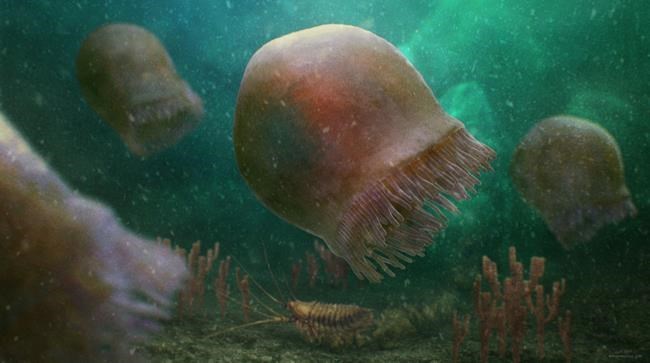The Royal Ontario Museum says it has discovered the oldest-known swimming jellyfish in the fossil record from specimens collected at the Burgess Shale in the Canadian Rockies.
The newly named Burgessomedusa phasmiformis, which means Burgess Shale jellyfish with a ghostly form, was found among the fossils that had been collected from one of the sites at Yoho National Park in British Columbia in the 1980s and 1990s.
"This is a study that has been in the works ... for a long time," Joe Moysiuk, a PhD candidate in ecology and evolutionary biology at the University of Toronto, said in an interview.
"We've uncovered the oldest large swimming jellyfish that we know of in the fossil record."
The research was published Tuesday in the journal Proceedings of the Royal Society B.
Moysiuk said the fossils of the 505-million-year-old jellyfish had been sitting on a shelf at the Royal Ontario Museum for decades until they were studied by his lab mate, Justin Moon, who's lead author on the paper.
"This was part of his PhD research and I got to help him out."
Moysiuk said the discovery pushes back estimates on the timing of the origin of a group of animals called Cnidaria.
"Jellyfish are members of this modern group of animals, including corals and sea anemones and some of their other relatives, which are all characterized by this blobby body with a series of tentacles with stinging cells."
Most of those animals, he noted, spend their entire lives on the sea floor.
"The jellyfish group has evolved this innovation where they undergo this two-part life cycle," said Moysiuk. "For the first part of their life, they look a little bit like an anemone sitting on the sea floor and then they undergo this metamorphosis and turn into the things that we commonly think of when we think of jellyfish.
"This discovery is showing us that this evolutionary innovation was already present half a billion years ago in the Cambrian."
The Royal Ontario Museum said in a statement that the fossils were exceptionally well preserved at the Burgess Shale, considering jellyfish are about 95 per cent water. The nearly 200 specimens, it added, have remarkable details of internal anatomy and tentacles, with some measuring more than 20 centimetres long.
"Finding such incredibly delicate animals preserved in rock layers on top of these mountains is such a wondrous discovery," co-author Jean-Bernard Caron, curator of invertebrate paleontology at the museum, said in a statement.
"Burgessomedusa adds to the complexity of Cambrian foodwebs, and like Anomalocaris, which lived in the same environment, these jellyfish were efficient swimming predators.
"This adds yet another remarkable lineage of animals that the Burgess Shale has preserved chronicling the evolution of life on Earth."
The Burgess Shale, which is managed by Parks Canada and located in both Yoho and Kootenay national parks, is widely known as one of the most significant fossil sites in the world. It contains fossil evidence of some of the earliest animals that existed in the oceans about 508 million years ago and was designated a UNESCO World Heritage Site in 1980.
This report by The Canadian Press was first published Aug. 1, 2023.
Colette Derworiz, The Canadian Press




